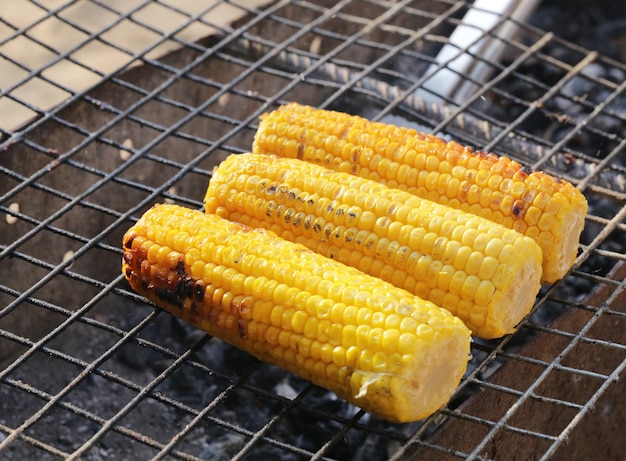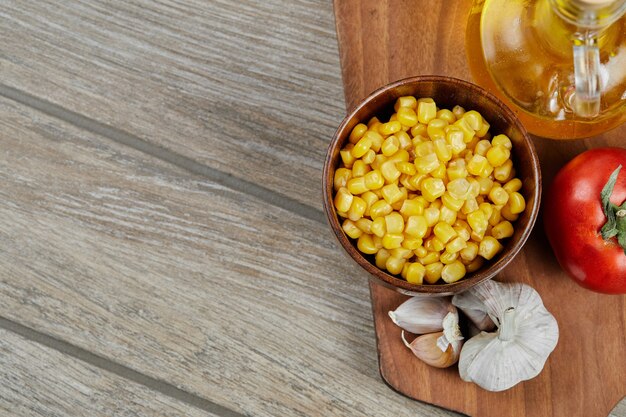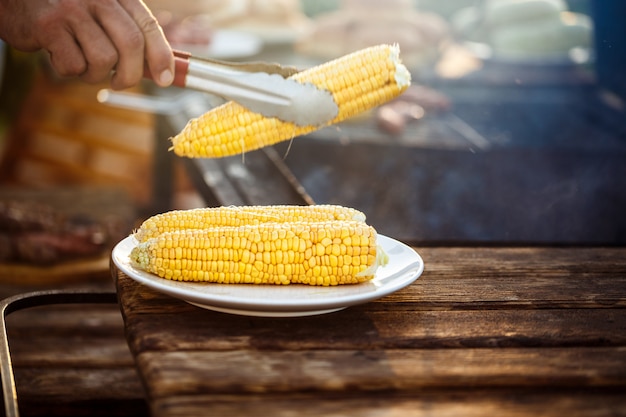As a self-proclaimed corn on the cob enthusiast, I’ve tried it all: grilling, roasting, microwaving – you name it. But there’s something about the simplicity and flavour of stovetop corn that always brings me back. It’s a method that’s been passed down through generations in my family, and I’m here to share the secret with you. Let me tell you, it’s the perfect way to achieve that sweet, juicy, and slightly charred corn that you just can’t get any other way. Trust me, once you try this method, you’ll never go back.
(Part 1) The Essentials: Setting the Stage for perfect corn

Before we get into the nitty-gritty of the cooking process, let's talk about the crucial ingredients that will make or break your corn on the cob experience. You’ll need:
1. Corn on the Cob: The Star of the Show
This is the heart and soul of your dish, so choose wisely! The key is to go for corn that’s fresh and plump, with vibrant green husks. If you’re buying from a supermarket, make sure the husks are tightly wrapped around the ears, and the kernels look full and milky. Ideally, you want to use corn that has just been harvested, or at the very least, within a week of being picked. The fresher the corn, the sweeter it will be, and the more pronounced those lovely, juicy kernels will be.
Here's a little tip: If you’re buying your corn from a farmers' market or a local farm, ask the vendor when the corn was picked. They’ll be happy to share their expertise, and you’ll get the freshest corn possible.
2. Water: The Unsung Hero
This might seem obvious, but it's crucial to use fresh, clean water for boiling your corn. It's the foundation of your cooking, and the quality of your water can influence the taste of your corn. You’ll need enough to cover the corn completely, plus a couple of inches to make sure it’s properly submerged. You want the corn to be swimming in the water, not crowded and fighting for space.
3. Salt: The Secret Weapon
Salt is a game-changer in cooking, and it’s no different for corn on the cob. Just a pinch of salt in the boiling water will bring out the natural sweetness of the corn and enhance the flavour. Don’t go overboard though – just a touch is all you need. It’s not about making the corn salty, but about unlocking those hidden flavours. Think of it as a secret ingredient that makes all the difference.
4. Butter and Seasonings: The Finishing Touches
Now, this is where you get to unleash your inner chef. While butter is a classic addition for a rich and creamy flavour, you can get creative with seasonings. I’m a big fan of a sprinkle of smoked paprika, chili flakes, or even a squeeze of fresh lime juice for a bit of zing. The possibilities are endless, so let your taste buds guide you.
(Part 2) Preparation: Setting the Stage for Success

Now that you’ve got your ingredients ready, let's talk about the crucial preparation steps that make all the difference in achieving that perfect corn on the cob. It's all about the details, and a little extra effort goes a long way.
1. Shucking the Corn: A Delicate Operation
First things first, you need to remove the husks and silks from your corn. Now, some people swear by shucking the corn right before boiling, while others prefer to do it in advance. Honestly, I’ve tried both ways, and I’ve found that shucking ahead of time makes the whole process a little easier. You can even remove the silks beforehand, leaving you with perfectly clean corn ready to cook. This is a great tip for large gatherings or if you’re short on time.
When shucking the corn, be gentle! You want to remove the husks without damaging the kernels. Think of it like peeling back the layers of a delicate flower.
2. The Secret to Crisp and Juicy Corn: The Cold Water Immersion
This is where the magic happens. Once you’ve shucked your corn, it’s time to immerse it in cold water. Yes, you heard that right, cold water! Let the corn soak for at least 30 minutes before you start boiling. This little trick will make the corn kernels plump and juicy, ensuring that they stay perfectly crisp even after cooking.
The cold water helps the corn absorb moisture, making the kernels plump and juicy. It's a simple step, but it makes a big difference in the final outcome.
(Part 3) The Stovetop Method: A Step-by-Step Guide

Now, let's get down to the business of cooking. I find this method is super simple and yields consistently delicious results every time. Here's how it works:
1. The Boiling Water: The Heart of the Process
Start by filling a large pot with enough water to cover the corn completely, plus a couple of inches for good measure. You want the corn to be swimming in the water, not crowded and fighting for space. Add a pinch of salt to the water and bring it to a rolling boil.
The salt will help to enhance the flavor of the corn, and the boiling water will ensure that the corn cooks evenly. You want the water to be bubbling vigorously, but not overflowing.
2. The Corn Goes In: A Gentle Descent
Once the water is boiling, carefully lower the corn into the pot, making sure it’s fully submerged. You want to make sure the corn is evenly submerged in the water so it cooks evenly. The corn should be fully immersed in the boiling water to ensure even cooking. Don't crowd the pot – give the corn some space to move around freely.
3. The Timing Is Key: Finding That Perfect Balance
Now, for the timing: Most people recommend boiling corn for 5-7 minutes. However, I’ve found that this can sometimes lead to overcooked corn, especially if your corn is particularly fresh and plump. So, I always check the corn after 4 minutes. You can tell it's ready when the kernels are tender but still slightly firm when pierced with a knife.
The goal is to cook the corn just enough so that the kernels are tender but still have a bit of a bite to them. Overcooked corn can become mushy and lose its flavor.
4. The Cooling Process: Preserving That Crisp Texture
Once the corn is cooked, transfer it to a colander and drain thoroughly. Then, run cold water over the corn to stop the cooking process and prevent it from becoming mushy. This is important to maintain that crisp texture.
The cold water shock helps to stop the cooking process and preserve the corn's crisp texture. It's an essential step for achieving that perfect balance of sweetness and crispness.
(Part 4) The Finishing Touches: Adding Your Personal Flavour Signature
Now, it's time to get creative with your finishing touches. This is where you can really make your corn on the cob stand out. It's your chance to add your personal flavour signature and impress your guests.
1. The Classic Butter and Salt: A Timeless Combination
A simple sprinkle of salt and a generous pat of butter is the ultimate classic. It's a flavour combination that never fails to please. It's simple, it's delicious, and it's a guaranteed crowd-pleaser.
2. Spice Up Your Corn: A Touch of Heat
For those who like a little heat, a sprinkle of chili flakes or a dash of cayenne pepper adds a fiery kick. You can also try a pinch of smoked paprika or chipotle powder for a smokier flavor.
3. A Touch of Zest: A Bright and Refreshing Twist
A squeeze of fresh lime or lemon juice adds a bright and refreshing flavour that pairs perfectly with the sweetness of the corn. The citrusy acidity cuts through the richness of the butter and enhances the sweetness of the corn.
4. Herby Delights: Freshness and Flavor in Every Bite
Chop up some fresh herbs like cilantro, parsley, or chives and sprinkle them over your corn for a burst of freshness and flavour. The herbs add a touch of complexity and make the corn taste even more vibrant.
You can also try adding a touch of garlic powder or onion powder for a savory twist.
(Part 5) Beyond the Basics: Experimenting with Flavors
Here are some ideas for elevating your corn on the cob beyond the basic butter and salt, pushing the boundaries of flavour and creating culinary masterpieces.
1. The Smoky Corn: A BBQ Touch
Before you cook the corn, rub the kernels with a little smoked paprika and a dash of chili powder for a hint of smoky flavour. The smoky paprika adds a touch of depth and complexity, while the chili powder gives it a subtle kick.
2. The Mexican Corn: A Fiesta in Your Mouth
Combine a sprinkle of chili powder, cumin, and a pinch of cayenne pepper for a spicy kick. Then, finish with a squeeze of lime juice and a sprinkle of fresh cilantro for a truly authentic Mexican flavour. This combination of flavors is bold, vibrant, and sure to please.
3. The Italian Corn: A Mediterranean Twist
Dress your corn with a drizzle of olive oil, a pinch of dried oregano, a touch of garlic powder, and a sprinkle of grated parmesan cheese for a taste of Italy. The olive oil adds richness and a touch of Mediterranean flavor, while the oregano, garlic powder, and parmesan cheese complement the sweetness of the corn beautifully.
4. The Asian Corn: A Spicy and Sweet Treat
Combine a touch of soy sauce, sesame oil, a pinch of ginger powder, and a sprinkle of toasted sesame seeds for a flavourful and aromatic Asian-inspired twist. The soy sauce and sesame oil add a savory and nutty flavor, while the ginger powder and sesame seeds provide a touch of heat and complexity.
(Part 6) Storage: Making Your Corn Last Longer
You know how it is – sometimes you end up with more corn on the cob than you can eat in one sitting. Here are some tips for storing your cooked corn, so you can enjoy its deliciousness for days to come.
1. The Fridge Method: Keeping It Fresh
Once your corn is cooked and cooled, wrap it tightly in plastic wrap or aluminum foil. This helps to retain moisture and prevent it from drying out. Store it in the refrigerator for up to 3 days. When ready to eat, simply reheat it by wrapping it in a damp paper towel and microwaving it for 1-2 minutes.
2. The Freezer Method: Longer-Term Storage
For longer storage, you can freeze cooked corn on the cob. Simply wrap the corn tightly in plastic wrap and then place it in a freezer-safe bag. When ready to use, defrost the corn in the refrigerator overnight and reheat it before serving.
frozen corn will maintain its texture and flavor for several months, making it a convenient way to enjoy corn on the cob throughout the year.
(Part 7) Serving Ideas: Beyond the Traditional
Here are some ideas for serving corn on the cob that go beyond the classic barbecue side dish, showing off its versatility and creating culinary masterpieces.
1. corn salad: A Light and Refreshing Option
Cut the kernels off the cob and toss them with chopped red onion, fresh cilantro, lime juice, olive oil, and a pinch of salt and pepper. Serve chilled as a side dish or use it as a topping for salads, tacos, or burritos.
The sweetness of the corn and the tangy lime juice create a refreshing combination that's perfect for warmer weather.
2. Corn Fritters: A Hearty Treat
Combine grated corn kernels with flour, eggs, milk, and spices. Drop spoonfuls of the batter into hot oil and fry until golden brown. Serve with sour cream or salsa.
These fritters are a delicious and satisfying appetizer or side dish. They're crispy on the outside and tender on the inside, with a hint of sweetness from the corn.
3. Corn Chowder: A Creamy and Comforting Soup
Combine corn kernels with potatoes, onions, and milk in a pot. Simmer until the vegetables are tender, then blend the mixture until smooth. Season with salt, pepper, and your favourite herbs.
This hearty soup is perfect for a cold winter day. It's creamy, comforting, and full of flavor.
(Part 8) FAQs: Your Corn on the Cob Questions Answered
1. What if my corn is too hard after cooking?
This could mean that the corn wasn't fresh enough, or it was overcooked. If it's too hard after cooking, you can try soaking it in cold water for 10-15 minutes. This can help to soften the kernels slightly. But if the corn is still too hard, it's best to just toss it.
2. How can I tell if my corn is ripe enough?
Look for corn with tightly wrapped husks and bright green kernels. If you can peel back a husk and the kernels are plump and milky, you're in luck! fresh corn is the key to delicious results. You can also test the ripeness by pressing on the kernels. If they are firm and bouncy, the corn is ready to go. If the kernels feel soft or dry, the corn might be overripe.
3. Why does my corn turn mushy after cooking?
The most common reason for mushy corn is overcooking. Make sure you don't boil the corn for too long. Aim for about 4-5 minutes for fresh corn, or a bit longer if you're using slightly older corn. Also, make sure you shock the corn in cold water after cooking to stop the cooking process and prevent it from becoming mushy.
4. How can I add more flavor to my corn?
There are endless possibilities for adding flavor to your corn. You can use a simple butter and salt combination, or get creative with spices like chili powder, smoked paprika, cumin, or oregano. Fresh herbs, like cilantro, parsley, or chives, can also add a burst of flavor. And don't forget about the power of citrus! A squeeze of lime or lemon juice can brighten up the taste of the corn.
5. Can I cook corn in the microwave?
You certainly can, but the results won't be as good as stovetop cooking. Microwaving tends to cook the corn unevenly and can result in a rubbery texture. For the best results, stick to stovetop cooking.
And there you have it, folks – the secrets to perfect stovetop corn on the cob. Now, you’re ready to impress your friends and family with your culinary expertise. Enjoy the sweet, juicy goodness of your homemade corn!
Everyone is watching

How to Cook Frozen Lobster Tails Perfectly: A Step-by-Step Guide
RecipesLobster. Just the word conjures up images of lavish meals, special occasions, and a taste of luxury. But let's...

Pigs in a Blanket Cooking Time: How Long to Bake for Perfect Results
RecipesAh, pigs in a blanket. Just the name conjures up images of those delightful little parcels of crispy pastry en...

Pork Fillet Cooking Time: How Long to Cook It Perfectly
RecipesPork fillet, or tenderloin as it's sometimes called, is a real favourite in our house. It's so versatile, and...

The Ultimate Guide to Cooking Delicious Frankfurters
RecipesLet's face it, we all love a good frankfurter. It's a classic, simple, and always satisfying. But let's be rea...

Wolf Meat Recipes: A Guide to Cooking Wild Game
RecipesLet's be honest, you don't see wolf meat at your local butcher shop every day. It's a bit of a wild card, but ...
